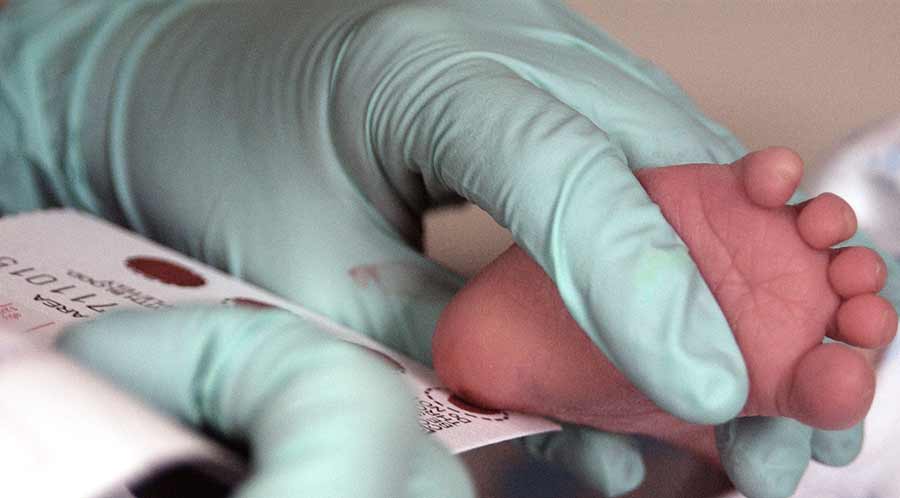Predicting autism risk may begin with a drop of blood
by Scott LaFee, UC San Diego
February 13, 2020

The UC San Diego Newborn Screening-Autism Risk Study is designed to determine whether the dried and stored blood drops of children later diagnosed with ASD contain within them the tell-tale presence and combinations of biological molecules and environmental chemicals that might predict the risk of a future ASD diagnosis.
Principal Investigator Robert Naviaux, M.D., Ph.D., [professor of medicine, pediatrics and pathology at UC San Diego School of Medicine] said the new study is important for two reasons: the dramatic rise in diagnosed cases of ASD and increasing evidence that early intervention in children at risk of ASD can significantly improve outcomes.
Naviaux and colleagues believe that the majority of ASD symptoms are the result of a treatable metabolic syndrome triggered by persistence activation of the cell danger response (CDR), a natural and universal cellular reaction to injury or stress. Chronic CDR, they suggest, results in disrupted and incomplete healing at the metabolic and cellular levels. In ASD, the consequence may be dysfunctional neural circuits and internal systems, producing autism’s well-documented symptoms and behaviors.
-----
Gene associated with autism also controls growth of the embryonic brain
by Sarah C.p. Williams, University of California, Los Angeles
FEBRUARY 12, 2020
A UCLA-led study reveals a new role for a gene that's associated with autism spectrum disorder, intellectual disability and language impairment.
The gene, Foxp1, has previously been studied for its function in the neurons of the developing brain. But the new study reveals that it's also important in a group of brain stem cells—the precursors to mature neurons.
During embryonic development, the protein plays a broad role in controlling the activity of many other genes related to blood, lung, heart, brain and spinal cord development.
"What we saw was that both too much and too little Foxp1 affects the ability of neural stem cells to replicate and form certain neurons in a specific sequence in mice," Novitch said. "And this fits with the structural and behavioral abnormalities that have been seen in human patients." Bennett Novitch is a member of the Eli and Edythe Broad Center of Regenerative Medicine and Stem Cell Research at UCLA, and a UCLA professor of neurobiology who holds the Ethel Scheibel Chair in Neuroscience.
-----
The Relationship Between Autism Spectrum Disorder and ADHD
Here's how to understand the diagnosis and treatment options.
by Benjamin Cheyette, M.D., and Sarah Cheyette M.D.
Posted Feb 08, 2020
Posted Feb 08, 2020
Behavioral disorders — ASD, ADHD, and all other psychiatric disorders — are generally not caused by a single biological abnormality or genetic mutation. Instead, each of these disorders can be caused by literally hundreds of genetic or biological variants, most often in combination, and they have other contributors too. Behavioral disorders may be caused by prenatal infection or other prenatal trauma, postnatal infection or other medical conditions, malnutrition, physical and emotional trauma, stress or other environmental issues both in the past and present — and of course, interactions between all these factors put together.
For years, the DSM stated that the diagnoses of ASD and ADHD were mutually exclusive. In the latest version of DSM, however, co-diagnosis is allowed. As it turns out, on the basis of simple symptom categorization, there is a fair amount of overlap between these two behavioral conditions. Here are some statistics: There is a 5-10% incidence of ADHD overall in children, and a 2-5% incidence of ASD. Based on DSM-5 criteria, around 50% of children diagnosable with ASD could also be diagnosed with ADHD, and around 15% of children diagnosable with ADHD could be also be diagnosed with ASD.
Why do these two disorders have so much overlap? For one thing, there is overlap in their behavioral signs and symptomatology. Both disorders make kids appear less engaged. Inattentive behavior in ADHD may cause affected children to miss social cues, for example, which can resemble mild ASD. Kids with ADHD have a higher rate of rejection by their peers, which can lead to them being more withdrawn, which may also resemble ASD. Children with both disorders may have, or develop, problems with empathy, as well as facial recognition.
Children with ASD and ADHD both have high rates of depression and anxiety. Impulsive behavior and deficits in planning (executive functioning) are common to both disorders. Both disorders include problems with pragmatic language, as well as with cognitive flexibility. Both disorders are more often found in the presence of intellectual disability or more specific learning disabilities such as in language, reading or motor skills. There may, in fact, be some underlying genetic or other biological factors common to both disorders: In many families where there is a child with ASD, there is a higher incidence of other family members who have ADHD (and vice versa).
Effective behavioral treatments for the two disorders also have some similarities and some differences: In ASD the major goal is usually to promote social skills development, whereas in ADHD the major goal is usually on managing executive tasks; but controlling impulsive behavior is often a therapeutic focus in both disorders. Many of the therapeutic techniques used in each disorder are similar. For example, the positive reinforcement of desired behaviors, achieving consistent quality sleep, engaging in regular exercise, and assembling appropriate educational support are important strategies for treating both disorders.
No comments:
Post a Comment